A Guide to British Wagtails
There are hundreds of bird species in the UK. Some are more recognisable than others due to characteristic and distinctive features such as appearance, size and sound. Others are lesser known, unless spotted by the more discerning bird-watcher.
However, there is a species which has a rather unusual habit, making it easier to identify. Scientifically known as the Motacilla family in a term dating back to 1758, but more commonly known as Wagtails, these delightful little birds are so called because they do just that – wag their tails frantically as they go about their business.
Wagtails are found around the world, such as the Mountain Wagtail, which ranges from Ethiopia to South Africa, to the Japanese Wagtail, found, as the names suggests, in Japan.
Here in Great Britain, however, we have three native species – the Pied Wagtail, the Grey Wagtail, and the Yellow Wagtail, which is a summer migrant.
In this article, we take a look at each of them, to find out more about these charming and animated characters.
Different types of Wagtail
Yellow Wagtail
The Yellow Wagtail is small and graceful and can be spotted almost ‘bobbing’ along the ground, wagging its tail as it goes. Its colouring is yellow or yellow with green tinges and it has a black beak. They are usually around 17cms long but can have a wingspan that extends between 23 and 27cms. They tip the scales at between 16 and 22g depending upon whether they are male or female.
Nesting birds can lay five or six eggs and chicks fledge after around 15 days. The typical lifespan of a Yellow Wagtail is three years but it has been known for one to make it to seven years-old.
Yellow Wagtails are resident in the UK in the summer months, so you will start seeing them in April onwards until they leave again in October, after which they move on to the warmer climates of the Sahara.
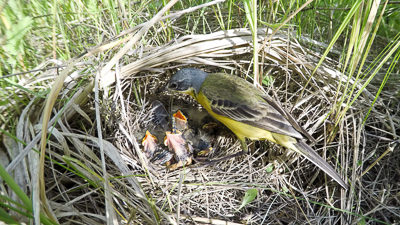
When in the UK, Yellow Wagtails are more likely to be found in central and northern England and they like to breed in grassy habitats, particularly near cattle.
There has been a major decline in numbers since the 1970s, which has been linked to the intensification of agriculture and the Yellow Wagtail is classed as extinct as a breeding bird in Ireland, where it is now only found while on passage.
However, there have been signs of more stable numbers over the last ten years in England.
Grey Wagtail
The Grey Wagtail is actually a brighter coloured bird than its name suggests. It is identified, again by a black beak, but also by its body of grey feathers with a yellow colour underneath and pink legs. Its tail is noticeable longer than those of Yellow Wagtails and bobs along as the bird moves.
Grey Wagtails are around 19cms in length and weigh between 14 and 22 grams. They will lay five eggs as a rule when nesting.
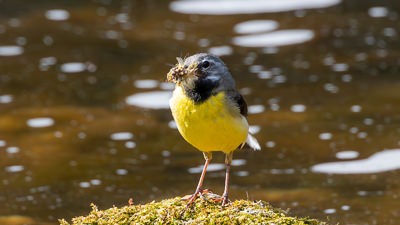
Spotted around water, and usually fast flowing water, the Grey Wagtail can also be seen along slower moving rivers and the edges of lakes and ponds in towns and cities. It is widespread in Britain and Ireland and can be seen all year round. They are less common on higher ground in the winter months and the Grey Wagtail does migrate to negate freezing conditions, spending the UK’s colder months as far away as North Africa.
There are an estimated 37,000 breeding pairs of Grey Wagtails in the UK and the species is listed as Amber on the Birds of Conservation Concern. Grey wagtails eat ants and midges that they find beside rivers, and snails and tadpoles they find in shallow water. They tend to nest near the water in hollows and crevices lined with moss and twigs.
Pied Wagtail
The Pied Wagtail is the most common Wagtail species in Britain and Ireland and despite its black, white and grey feathers, it is a cheerful sight to behold, especially with its distinctive tail bobbing as it races across the ground. Another of its more distinctive features is a ‘bib’ of black feathers on its chest.
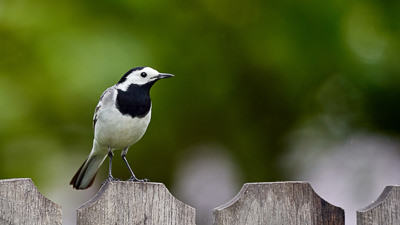
They weigh a little more than other Wagtails with an average weight of up to 25 grams and average size of 18cms. They will lay five to six eggs when nesting and will usually survive up to three-years-old. However, ringing records do show that one lived for more than 11 years. They tend to feed on mainly insects and seeds, but will also take household scraps in winter.
Pied Wagtails are good at adapting to different environments so can be seen in urban areas, even city centres, suburbs, near the sea, and around more open spaces such as farms, wetlands and grassland. It is partly due to this ability that the numbers of Pied Wagtails much higher than the Yellow or Grey species. There are an estimated 470,000 breeding pairs in the UK.
Attracting Wagtails to Your Garden
You can do plenty to attract Wagtails into your garden to help them thrive, but, due to the differing habitats and food sources that they enjoy – the things you need to do will differ between each type of Wagtail.
With Pied Wagtails, large gardens which are close to water are more likely to be favoured by them and the number of Pied Wagtails spotted in gardens increases during winter months.
Although Pied Wagtails generally eat invertebrates, like insects, they may be tempted by crumbs scattered on the ground. So, if you have any cooking left overs that you can put out for them, this may well take their fancy.
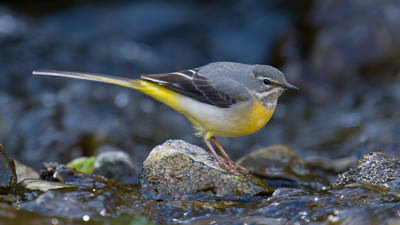
Grey Wagtails are much less likely to appear in your garden, unless you have your own stream or beck running through it, and of course, they are quite low in numbers which doesn’t help your chances. If they do appear though, they are unlikely to eat nuts and seeds from bird feeders as they are not the regular diet of a Grey Wagtail. As their preferred food is water insects and invertebrates then anything you do to increase these in your garden may attract Grey Wagtails.
Yellow Wagtails prefer the food and environment around farms and land so if you are a farmer or a landowner there are steps you can take to help Yellow Wagtails survive and any small changes you can make would help as these birds are in drastic decline.
Take care not to accidentally disturb active nests as they are placed close to the ground and if you own land consider grass or spring crops that can be used by Yellow Wagtails for nesting. If possible, also avoid using harsh chemicals to remove insects from your garden or land as these are a valuable food source for this bird.
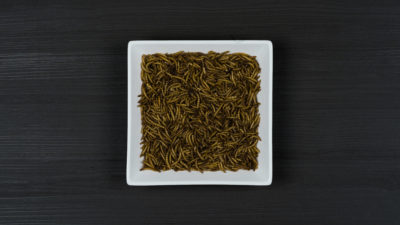
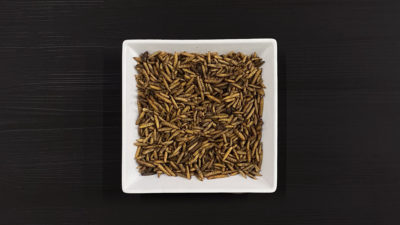
At Johnston & Jeff, we have a number of specially formulated nutritious blends that are suitable for Wagtails including Dried Calciworms and Dried Mealworms, which will give them plenty of high quality insectivorous proteins; our Ground and Table, formulated for birds that feed on the ground; and our Fat Balls and suet products which provide an abundance of calories.
For the full list of foods Wagtails will love, click here
Our recent posts giving advice and guidance on wild birds
Starlings and one of nature’s finest spectacles
Reading Time: 8 minutes Despite being one of the most well-known garden birds in the UK, the Starling is actually one of the species we need to be the most concerned about? They are considered to be one of the fastest declining birds in the UK and have been cropping up on the UK Red List of Conservation Concern for more than 20 years now. In this article we take a look at that mesmerising phenomena that is murmuration, as well as their wider behaviour.
A Guide to British Wagtails
Reading Time: 9 minutes Wagtails are delightful little birds and are so called because they do just that – wag their tails frantically as they go about their business. In Great Britain, we have three native species – the Pied Wagtail, the Grey Wagtail, and the Yellow Wagtail, which is a summer migrant. In this blog, we take a look at each of them, to find out more about these charming and animated characters.
Drum Roll for the Woodpecker, One of the UK’s Best Loved Birds
Reading Time: 10 minutes One of the most intriguing and evocative sounds in British woodlands is the Woodpecker tapping on tree trunks. But is the UK home to any other varieties of Woodpecker and if so, do they drum? In this blog, we take a closer look at one of Britain’s best loved and most iconic birds and unveil the secrets of their unique behaviour.






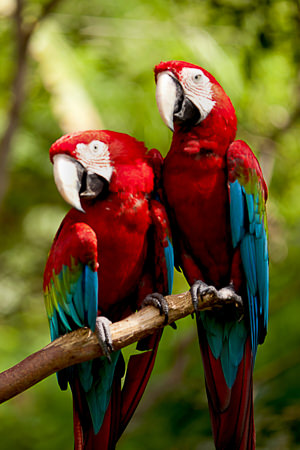
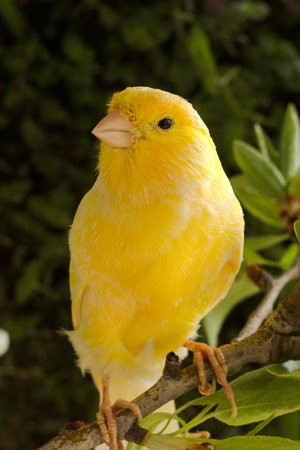

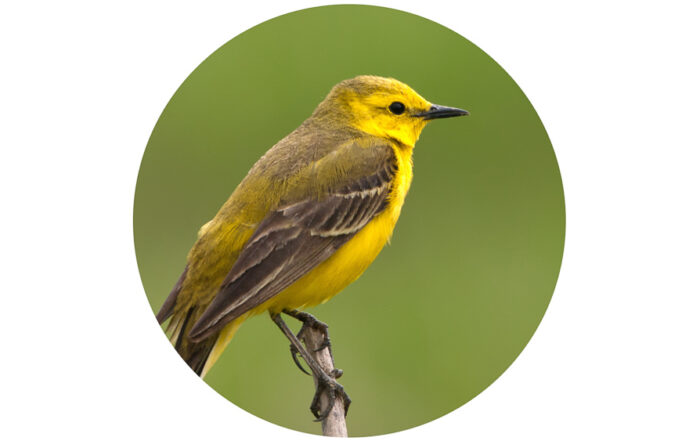
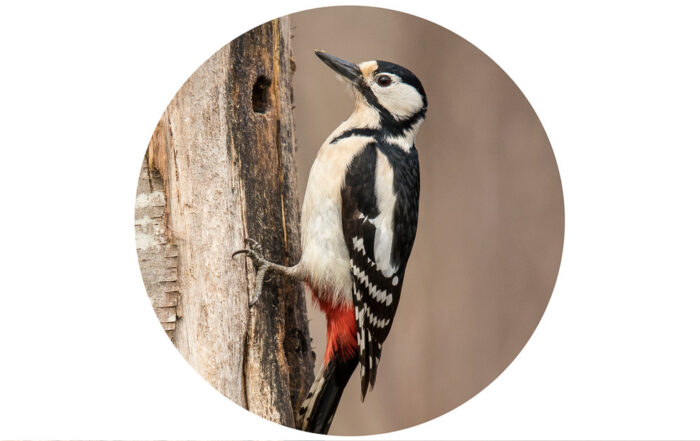
Leave A Comment